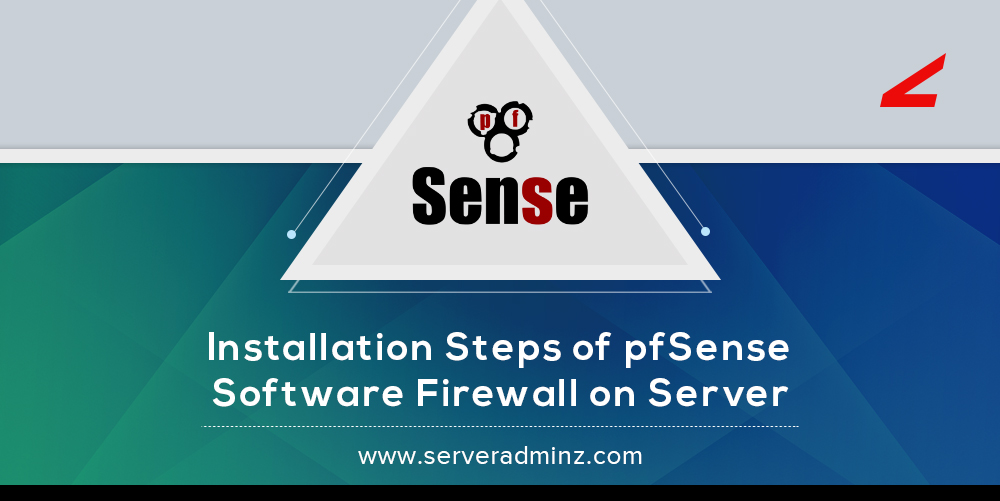A FreeBSD operating system based firewall software is pfSense which is open source and available with free of cost.
pfSense software is utilized to make a dedicated firewall for the dedicated server network. We can use different third-party software packages with pfSense firewall for the additional functionality. pfSense supports traffic shopper, virtual IP, Load balancer and much more. pfSense has several Diagnostics tool by default.
Hardware Requirements
Pentium II Processor, 256MB RAM, 1GB of HDD Space, CD-ROM.
2 Ethernet Card’s, Pfsense ISO file.
Please follow the the basic instructions on how to install pfSense 2.3.4 version Firewall.
You will get the pfSense ISO image from the authorized website, https://www.pfsense.org/download/.
We utilize the CD/DVD ISO for the pfSense installation. We will access the remote server by using IPMI/KVM console and attach the downloaded ISO image on the remote server and start the installation.
Step 1: Boot the pfSense Installation CD/DVD media, then select “Boot Multi-User” option and “Enter key” to get start the installation process.
At this screen select 1 to proceed to boot with the multi-user.
Click on ‘Accept these settings’ if everything is displayed in the native language.
We will see a utilizer with the option of ‘Quick/Easy Install’ or more advanced options in the next screen.
At this screen please confirm to use the ‘Quick/Easy Install’ method.
Please select the kernel you may wish to install on the next step.
‘Standard Kernel’ would be the best option. Let’s select ‘Standard Kernel’ to proceed further.
Now it will prompt for a reboot when the installer finishes the previous stage.
Be sure to remove the installation media as well so the machine doesn’t boot back into the installer.
pfSense Configuration
After the reboot, the server will boot into the newly installed operating system.
pfSense will pick an interface WAN and configure with DHCP so we need to configure the LAN interface.
Please follow the below-mentioned steps to configure IP address on the LAN interface.
#Remember which interface name is the WAN interface (em0 above).
#Type ‘1’ and press ‘Enter’ key and Type ‘n’ and press the ‘Enter’ key when asked about VLANs.
#For the LAN interface, type the proper interface name and hit the ‘Enter’ key. In this install, ‘em1’ is the LAN interface.
#Once all the interfaces have been assigned please hit the ‘Enter’ key again.
#Then we have to make sure that all the interfaces are assigned properly.
![]() #Once the interfaces are configured are correct, type ‘y’ and hit the ‘Enter’ key.
#Once the interfaces are configured are correct, type ‘y’ and hit the ‘Enter’ key.
#The next step will be to assign the interfaces the proper IP configuration. Please type ‘2’ and hit the ‘Enter’ key.
(Make sure correct interface name assigned WAN and LAN ).
The process for configuring a static interface on the LAN interface that is about to be configured.
#Type ‘2’ again when asked for which interface to set IP information. Again enter 2 for the LAN interface.
When prompted, type the IPv4 address desired for this interface and hit the ‘Enter’ key.
This address is used as the default gateway for the hosts.
The next prompt will ask for the subnet mask in what is known as prefix mask format.
For this network, we use /24 or 255.255.255.0.
Hit the ‘Enter’ key when done.
The next question will ask about an ‘Upstream IPv4 Gateway’. Currently, LAN interface is configured, simply hit the ‘Enter’ key.
The next prompt will ask to configure IPv6 on the LAN interface. Currently, using IPv4 so hitting the ‘Enter’ key will continue.
The next question will ask about starting the DHCP server on the LAN interface. Most home users will need to enable this feature.
We assume will allocate 51 addresses for other computers to obtain an IP address from the pfSense device.
The next question will ask to revert to HTTP as the web configuration protocol, type ‘n’ to continue.
Please hit ‘Enter’, pfSense will save the interface changes and services on the LAN interface.
The pfSense will provide the web address to access the web configuration and web interface is accessed through a web browser by IP address assigned on the LAN interface.
The default login information for pfSense as follows:
Username: admin
Password: pfsense
Enter in admin as username and pfsense as password.
That’s all…
” margin_top=”50px” margin_bottom=”” animation_type=”slide” animation_direction=”left” animation_speed=”0.3″ class=”” id=””]











Leave A Comment
You must be logged in to post a comment.